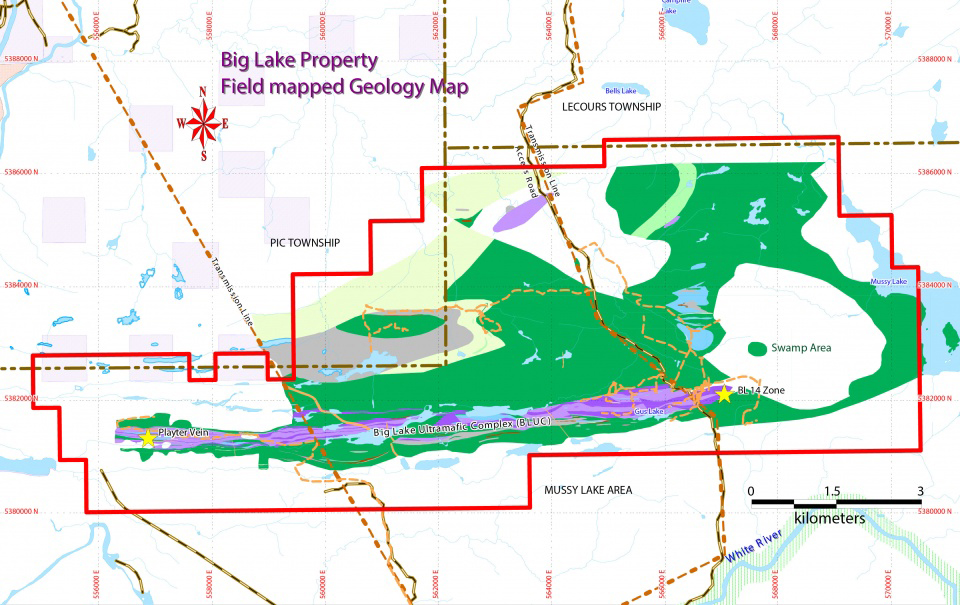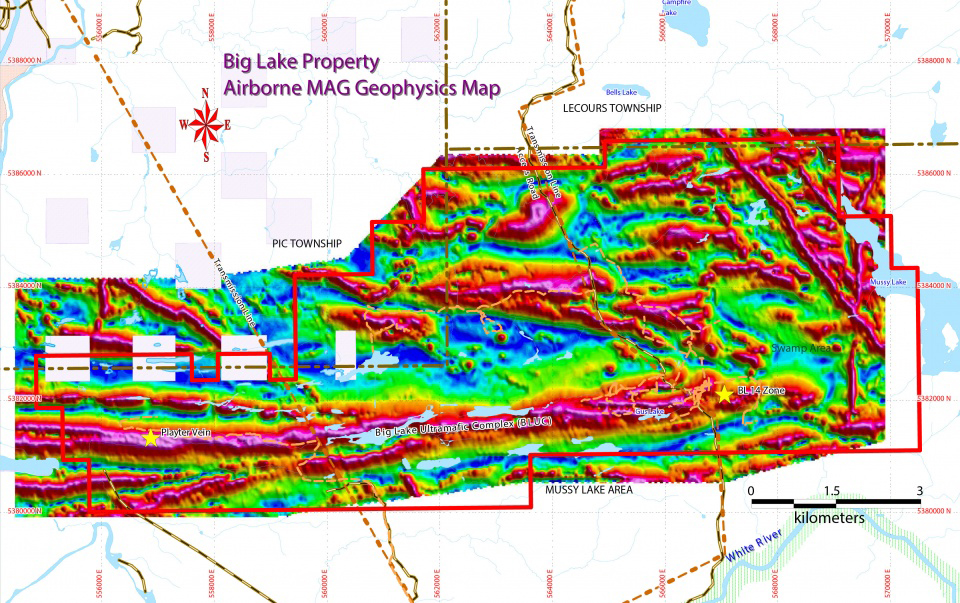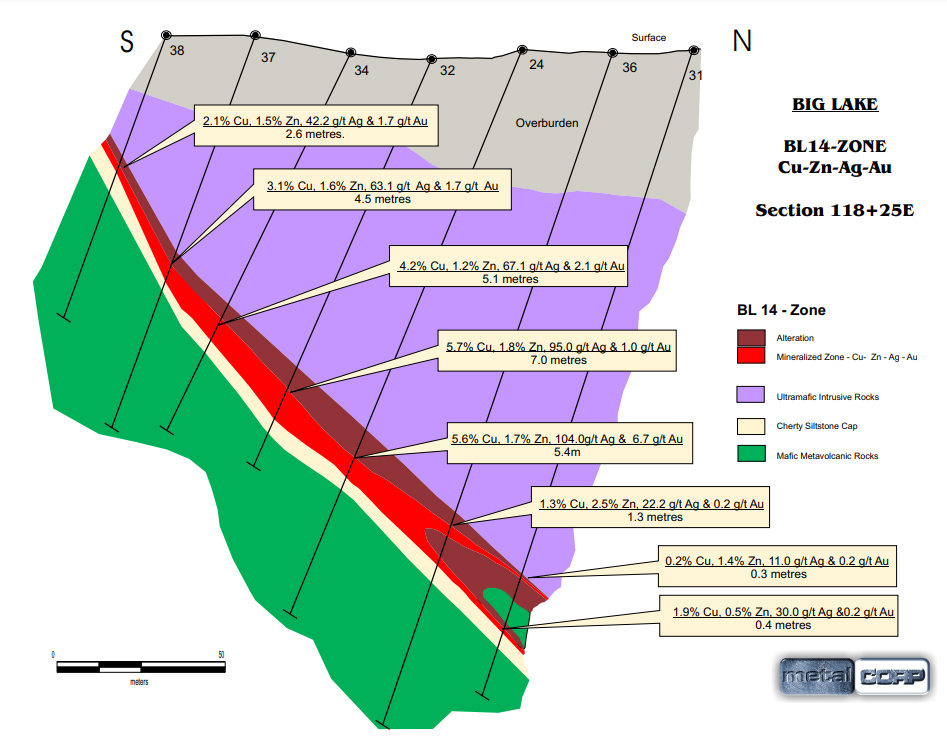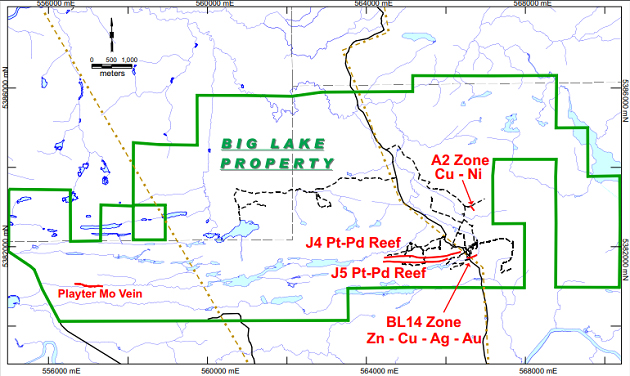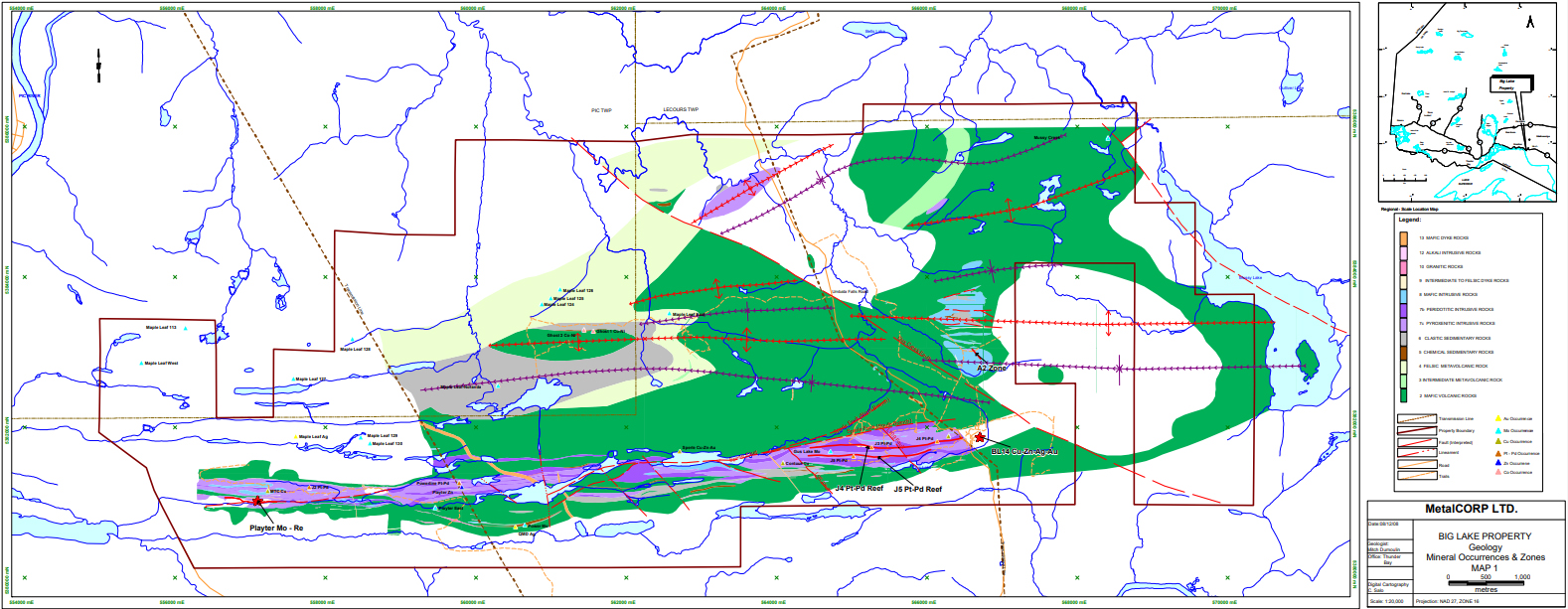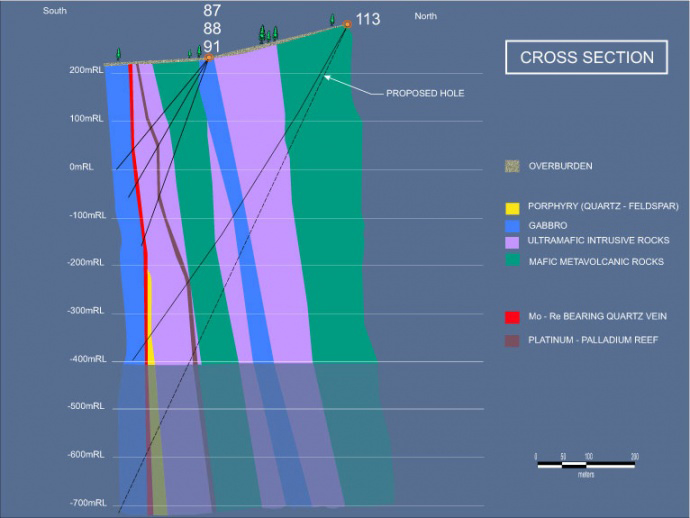Big Lake: Copper, Zinc, Nickle, PGE
Ontario, Canada
Status
Tier 2 Project, available for Joint Venture
Target
- Gold-rich Copper-Zinc-Lead Volcanogenic Massive Sulphide ("VMS"), (primary)
- Magmatic Nickel-Copper-PGE (secondary)
- Vein hosted Rhenium-Molybdenum (secondary)
Location and Setting
Location map of the Big Lake Property
The Big Lake Project is located in located in Northwest Ontario, approximately 20km southeast of the town of Marathon, and 10 km southwest of the Hemlo gold mine.
The eastern part of the property is accessible by a private road leading from the Trans Canada Highway. Access to the western part of the property, where the topography is quite rugged, requires helicopter support.
Land Status
The property is 100% owned and consists of 319 cell claims covering 6,539 hectares.
Geology and Mineralization
The Big Lake property is host to three different styles of mineralization. Currently the primary target is Gold-rich Copper-Zinc VMS mineralization found in the BL 14 Zone; however widespread magmatic Nickel-Copper-PGE mineralization such as the A2 zone and J4 & J5 Reefs, and vein hosted Rhenium-Molybdenum mineralization also occurs on the property and have at various times be the primary focus in the past.
Geology map of the Big Lake Property with BL 14 VMS Zone and Playter Rhenium-Molybdenum deposit, indicated by yellow stars.
Total field magnetic map of the Big Lake Property with BL 14 VMS Zone and Playter Rhenium-Molybdenum deposit, indicated by yellow stars.
BL 14 Zone: Gold-rich Copper-Zinc VMS
In March of 2006 a discovery of high-grade mineralized base metals was announced in diamond drill hole 24 which assayed 7.5% Copper, 2.2% Zinc, 138.0 g/t Silver and 9.2 g/t Gold over 4.0 metres (13.1 feet). The massive sulphide zone, referred to as BL14, was discovered while testing a broad EM conductor.
Identified are two (2) high grade copper-zinc massive sulphide lenses with associated stringer mineralization measuring 300m in strike length by 250m deep and approximately 3.0m wide which may be interpreted to be VMS type deposits (lenses). VMS type deposits tend to occur in clusters as noted from the base metal mining camps of Canada and the rest of the World.
The BL14 Zone displays many characteristics of a VMS mineralizing zone but with unusually high-grade copper, silver, gold and cobalt content. The zone resembles a high temperature Cu-Ag-Au rich VMS stringer or feeder zone. The zone occurs within komatiitic basalt of the Playter Harbour metavolcanic sequence and is interpreted to be a copper stringer zone associated with a VMS hydrothermal system. The zone is made up of bands, veins and stringers of chalcopyrite and pyrite, and contains up to 5% disseminated sphalerite, with minor galena.
The footwall to the BL14 mineralized zone is composed of strongly chloritized and biotitized metavolcanics. All holes have intersected varying amounts of chalcopyrite, sphalerite and pyrrhotite hosted by an intensely hydrothermally altered package of mafic metavolcanic rocks and associated interflow clastic metasedimentary rocks with deformed bands of chert.
High-grade Copper-rich VMS core from the BL 14 Zone
Cross section of the BL 14 Deposit
Recent Exploration
Over 100 diamond drill holes have been completed on the Big Lake Property and one surface geophysical survey, two airborne MAG/EM surveys and two down hole geophysical surveys. The most recent geophysical survey was completed by Quantec Geoscience in late 2008 and consisted of a deep penetrating Titan 24 system which penetrates deeper than conventional surveys and therefore beyond the depths of drilling completed to date on the BL14 base metal zone. In March 2009 the Company announced that the Titan 24 survey had identified 24 targets.
In the second quarter of 2009 Quantec was retained to compile and re-interpret all the geophysical survey data combined with the known geology on the Property to refine and re-prioritize drill targets.
In October 2009, Quantec's preliminary re-evaluation was announced and identified four zones for further exploration at and around the BL-14 copper-zinc deposit. These anomalies are referred to as:
- Zone 3 — a cluster of anomalies along the intersection of two faults potentially related to BL-14
- Zone 2 — related to the previously identified J4 and J5 Pt-Pd bearing ultramafics
- Zone 1 — a possible extension of base metal mineralization related to BL14 along strike to the east and west. Additionally, a "large conductive plate" north and sub-parallel to the BL-14 zone has been identified.
- Zone 4 — a possible down-dip extension to the A2 mineralization and an anomaly "similar to that of the BL-14 zone."
This latest program shows the BL14 Cu-Zn zone to have considerable potential for expansion and that a second source of mineralization may be nearby.
In December 2009, a follow-up drill program was initiated at Big Lake and was focused, in part, on test targets arising from a largely geological and geophysical re-evaluation of previously obtained data which was completed earlier in 2009 by Quantec Geoscience. This phase of drilling may continue beyond the end of 2009 into the first quarter of 2010.
The highest priority drill targets in the vicinity of the BL14 zone were selected for a second drill program on Big Lake. The targets tool into consideration the recommendations put forward by Quantec as well as an abundance of diamond drill and surface geological data acquired previously. The focus was on locating an extension to the known mineralization at the BL14 zone, and/or discovery of a new, associated, mineralized zone nearby.
In addition, in November 2009, a Memorandum of Understanding (MOU) was signed with the Pic River First Nation (PFRM), the First Nation in closest proximity to the Big Lake property, to facilitate access to the drill locations.
A2 Zone, J4 & J5 Reefs: Nickel-Copper-PGE
The Big Lake Property is associated with several magmatic Nickel-Copper-PGE zones of mineralization.
The mafic metavolcanic Pulpwood-Playter Harbour Sequence has been intruded by the strongly magnetic, east-west-trending, moderately north-dipping, sill-like Big Lake Ultramafic Complex which hosts the J4 and J5 Reefs. The complex is up to 350 m thick, with a strike-length in excess of 30 km (11 km within the Big Lake Property), and exhibits a prominent, east-west-trending, airborne magnetic anomaly that is observed to extend well into Lake Superior.
The complex is composed of several, similar, alternating sequences composed of fine-grained, serpentinized to talcose peridotite; fine- to medium-grained pyroxenite, ferro-pyroxenite, ferrowebsterite, and websterite; and medium-grained, often coarsely to very coarsely disequilibriumtextured (harrasitic), feldspathic pyroxenite, melagabbro, and sometimes gabbro.
Located, immediately west of the BL14 zone, two parallel nickel-copper-PGE-bearing "reef" zones are associated with the Big Lake ultramafic complex. The J4 and J5 Reefs occur within 2 peridotite units near their upper contact with pyroxenite. The J4 Reef returned 0.76 g/t Pt and 0.80 g/t Pd over 2 m, while the J5 Reef returned 0.83 g/t Pt and 0.84 g/t Pd over 2 m. Both reefs have been traced by drilling over strike lengths of approximately 1.5km and to a depth of 200m
The mafic metavolcanic rocks of the eastern portion of the property are intruded by two mafic to ultramafic intrusions, which are separated form the Big Lake ultramafic complex. The best known is the 2 km long, up to 750 m wide, strongly deformed, irregularly shaped, moderately to strongly magnetic, Gus Creek Mafic Intrusion, the southeastern margins of which are crosscut by the A2 Sequence intrusion breccia which hosts the A2 Nickel-Copper Zone.
A2 mineralization occurs within the complex, inclusion-rich, often varitextured, fine- to medium-grained to locally coarse-grained, melagabbroic to gabbroic A2 Sequence intrusion breccia that apparently crosscuts the supracrustal stratigraphy. The A2 Sequence may be the remnants of a magma conduit and is usually mineralized throughout. The A2 Zone, has been traced along strike and to depth for approximately 200m, yielded up 1.7% Ni and 1.4% Cu over narrow intersections in drilling.
Location map of the A2 Zone, J4 and J5 reefs (the property boundary is out of date, est. 2008)
Geology map of Big Lake Property with emphasis on mafic-ultramafic phases of the Big Lake Ultramafic Complex
Zoom in of the geology map of Big Lake Property with emphasis on mafic-ultramafic phases of the Big Lake Ultramafic Complex.
PLAYTER Deposit: Rhenium - Molybdenum
The Playter Molybdenum (Mo) - Rhenium (Re) Project is located at the western end of the Company's 100% owned Big Lake Property
The Project is focused on a large Mo-Re bearing quartz vein that was discovered in the 1930's and was first drilled to only 200 metres depth with a 20-hole diamond drill program in 1972.
The Mo/Re mineralization is associated with a steeply dipping, east-west striking quartz vein that varies between one and 10 metres in width. It is approximately one kilometre long and is hosted in an amphibolite metamorphic facies ultramafic/mafic volcanic sequence.
23 diamond drill holes for a total of 12,055 metres were drilled and intersected the quartz vein from 200 to 600 metres deep. The drilling has shown the Mo-Re vein to be 750m in strike length, 600m deep with an average true width of approximately 7.0m. The vein remains open at depth, with a possible plunge to the west. Molybdenum intercepts range from 0.04% to 0.29% and rhenium grades range from 0.6 g/t to 1.7 g/t.
Although drilling to depths of 650 metres it did not test the upper 200 metres. However, historical drilling and surface exposures of the vein had demonstrated similar styles of mineralization and tenors within this interval. The continuity of the geology, especially the mineralized quartz vein, is well established and the quartz vein and mineralization is open at depth.
In the second quarter ended June 30, 2008, the Company retained AMEC Americas Ltd to complete an NI 43-101 report and resource estimate of the Playter vein.
- Inferred resource of 0.9 million tonnes grading 1.67 g/t Rhenium, 0.25% Molybdenum, and 3.38g/t Silver
Rhenium is a rare metal with unique characteristics and is becoming a vital part of the aerospace industry. Demand for Rhenium continues to grow as environmentally friendly airplane engines become more popular. The metal is mainly used in high temperature super-alloy turbine blades in jet engines, land-based gas-powered turbines and petroleum-reforming Platinum-Rhenium catalysts.
Molybdenum is used as an alloying agent in steel to enhance strength and resistance to wear and corrosion. It is also used in lubricants developed for high temperature and pressure applications.
Proposed Exploration Program
Additional Bore Hole Electromagnetic Surveys ("BHEM") by additional diamond drilling is recommended on the BL 14 Copper-Zinc VMS deposit to identify extension of known mineralization another yet to be identified VMS lenses.
Additional work is also recommended to trace the A2 Nickel-Copper style mineralization in search of chonolith / feeder dyke, Voisey's Bay/Norlisk style mineralization.
Agreement and Terms
All claims are 100% owned.


